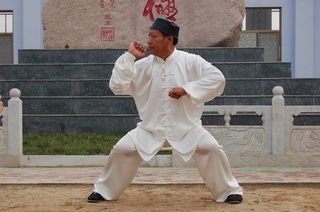Principles of BajiQuan
Technical features
Master Wu LianZhi in the typical "LiangYi Ding" position
It is difficult to summarize in a few words all the characteristics of BajiQuan, but the following elements can be highlighted:
Stance training : one of the training fundamentals implies immobile training of the “LiangYi Ding (两仪顶)” stance, known as the“Two principles (Yin and Yang) stance”. This position (cf. picture below) is the trademark of BajiQuan, and is probably inspired by the traditional Chinese character corresponding for the Wu (吳) family name of the MengCun Wu family. This stance allows a perfect equilibrium of the body, and harmony between the sky (Yang) and the earth (Yin) and favours various essential components of the training : rooting, reinforcement of the lower limbs, circulation of internal energy in the principal meridians of the body and its accumulation in the Dan Tian point.
Explosive power : BajiQuan is a style famous for its powerful strikes, which make use of the “explosive power” (爆发力, BaoFali). This power is obtained from a specific biomechanics of BajiQuan movements which is based on:
- the “6 big openings” (Liu DaKai, 六大开), which are 6 types of fundamental forces (Ding, Bao, Dan, Ti, Kua, Chan: thrusting, gathering, whipping, raising, hips rotation, and twining), and not 6 techniques as it is frequently incorrectly interpreted,
- 3 internal forces associated to footwork (Chen, Chuang, Nian: sinking, rushing, crushing),
- the circulation of Qi, called Xing Qi (行气), its accumulation and release from the DanTian via specific breathing processes (cf below).
When all these elements are perfectly synchronized on the shortest time-lapse, one can generate the Explosive Power which is characteristic for BajiQuan. However, this can only be achieved after a long training based on : the acquisition of basic techniques (i.e. JiBenGong, 基本功), the combination of these techniques in sequences or preset forms (i.e. Taolus, 套路), and finally their applications in free fighting.
Internal training: As indicated above, BajiQuan makes use of various internal exercises in order to improve the control of Qi. These exercises can be used either for martial applications (generation of the Explosive Power) or for therapeutic purposes. BajiQuan uses classical respiratory exercises (natural and contrary abdominal breathing), but it focuses more especially on an explosive technique of Qi circulation (called Xing Qi), which is based on the use of the “Heng” and “Ha” sounds punctuating the power releases.
Fighting techniques : BajiQuan is a style with simple appearance, with uncluttered techniques and where acrobatics are proscribed. The footwork is based on 5 fundamental positions, and it reflects the characteristics of 10 animals (dragon, tiger, bear, etc). One of the style characteristics is to use the 8 extremities of the body for striking : head, shoulders, hands, hips, knees, feet, coccyx and finally elbows which are a characteristic of BajiQuan. The hand techniques are based on the use of 10 traditional agricultural tools (hatchet, hammer, fork, etc) and the kicks are limited to the lower level in order to avoid exposing the crotch.
Fighting tactics: BajiQuan is a close range fighting style, which objective is to enter the opponent’s guard according to the principles “Ai, Bang, Ji, Kao” (挨, 膀, 挤, 靠: getting close, pushing with the shoulder, hustling and leaning on the adversary), and to simultaneously strike the lower, medium, and upper range of the opponent (San Pan Heji, 三盘合击). Concerning defences, movements of small amplitudes and close to the body are used in order to protect the central axis of the body. A simple principle is then followed: “The hands protect the head, the elbows protect the body, the knees protect the crotch, the feet protect the legs”.

